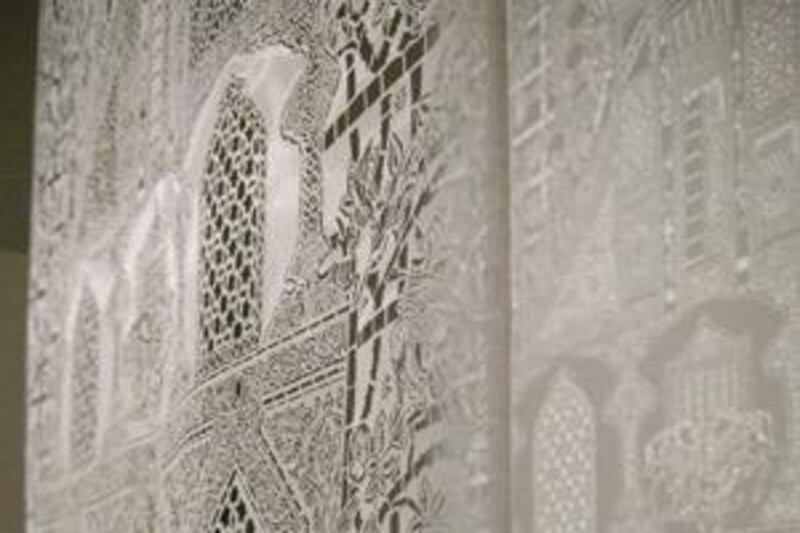A new international award for contemporary artists and designers inspired by Islamic traditions, and hosted by the Victoria and Albert Museum in London, has been awarded to the Iranian-born artist Afruz Amighi. She earned the Jameel Art Prize for her work 1001 Pages (2008), a series of pieces in which she uses light and shadow to create intricate patterns. Funded by the Saudi businessman Mohammed Abdul Latif Jameel, who also provided financial support for the renovation of the V&A's Jameel Gallery of Islamic Art, the prize aims to draw attention to the increasingly dynamic dialogue between contemporary practice and the rich Islamic heritage. The prize is awarded every two years.
More than 100 artists and designers were nominated last summer. Nine were shortlisted, including Hamra Abbas, Reza Abedini, Sevan Biçakçi, Khosrow Hassanzadeh, Susan Hefuna, Seher Shah and Camille Zakharia. Their works range from intricate pieces of jewellery to photomontage, turned wood and screen prints. They will be exhibited at the V&A along with the winning entry until Sept 13. For 1001 Pages (2008), the 34-year-old Amighi, who lives and works in New York, used a stencil burner to hand cut a thin, porous sheet of plastic - the same material used in the construction of refugee tents. The work is suspended and illuminated, casting an intricate pattern of shadows against the wall.
Mark Jones, the director of the V&A and the chair of the prize's judging panel, said: "Afruz Amighi has created something new, something that is skilful but which transcends that skill. The work is both striking and subtle, as well as being beautiful. Its use of projected light and shadow loosens the viewer's focus on the created object, marking a passage from the material to the immaterial." Amighi's work has been exhibited in New York, Boston and at Wake Forest University, North Carolina. By combining elements of Iranian architecture, myths and religion with textures from Persian carpets, curtains and prayer beads, she explores her country's tumultuous social and political history.
Work by contemporary Iranian artists has gained increasing prominence in recent years. In Unveiled: New Art from the Middle East, held earlier this year at London's recently relocated Saatchi Gallery, at least half of the works were by artists of Iranian descent. Of the shortlist for the Jameel Art Prize, three were Iranian, the most from any one country. Jameel proposed the prize with the aim of revitalising Islamic traditions by integrating them into contemporary art, to inspire a new generation of artists and to provide an infrastructure for contemporary art in the Middle East.
The panel of judges included Ali Yussef Khadra, the founder of the Middle East art magazine, Canvas; and Charles Merewether, the art historian, writer, curator and former deputy director of the cultural district on Abu Dhabi's Saadiyat Island. The Jameel Art Prize joins several other awards designed to encourage contemporary artists in the region. Though generous, the £25,000 (Dh148,000) prize money is dwarfed by that of the Abraaj Capital Art Prize, the world's most valuable competitive art award, which was awarded in January to three artist/curator teams, each of whom received around $200,000 (Dh734,600). Their works were exhibited at Art Dubai in March.
The Magic of Persia Contemporary Art Prize, which is open to emerging Iranian artists, announced its six finalists in April. Their works will be exhibited at the Royal College of Art in London to coincide with the opening of the Frieze Art Fair in October. A final winner will then be chosen by the jury and awarded the opportunity for a solo exhibition at a major London gallery. The Jameel Art Prize, however, is open to artists of any nationality who are inspired by the Islamic traditions of arts and crafts.
The V&A was a pioneer in the collection of Islamic art, and has specialised in its collection since the 1850s. Following an extensive three-year renovation, the Jameel Gallery reopened in 2006 and now houses more than 400 objects, including ceramics, textiles, carpets, metalwork, glass and woodwork, which date from the Islamic caliphate of the eighth and ninth centuries to the years preceding the First World War. The highlight is the Ardabil carpet, the world's oldest dated carpet and one of the largest and most historically important in the world.
An exhibition of work by the winner of the Jameel Art Prize and eight other shortlisted artists and designers is at the V&A Museum, London, until Sept 13. Visit www.vam.ac.uk.





